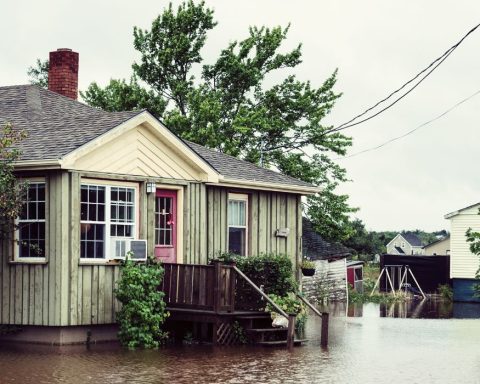Canadian provinces must rein in their expanding gas systems or risk incurring staggering costs from stranded assets and failure to meet net-zero targets, the Canadian Climate Institute (CCI) warns in a new report.
If provincial governments and regulators continue treating gas as the default option for heating new homes and commercial buildings, rather than shifting the lion’s share of that heating demand to an electrified system dominated by heat pumps, the transition off carbon will cost more than it needs to, the Institute warns. As households and businesses abandon the system for cheaper, more efficient electricity, the remaining ratepayers will be left with higher costs. And if those costs get so high that regulators decide they’re beyond ratepayers’ ability to pay, the burden will eventually shift to taxpayers.
“The critical thing is that we change our approach to expansion and that we think very seriously about how we’re going to deal with existing systems,” Senior Research Director Jason Dion told a media briefing Wednesday.
“We need to be thinking very carefully about whether [new gas infrastructure] is going to be used and useful over its lifetime,” he added, while dealing with the complexities of managing the existing gas network as demand for its product declines.
The report puts most of the onus on provincial governments, regulators, and utilities to deliver a viable path to net-zero heating in the buildings sector, which saw its emissions rise 8.8% between 2005 and 2022. Along with upstream oil and gas and agriculture, the sector is one of the few in Canada that have not managed to bring their emissions down.
The report pins much of that problem on the way buildings are heated, with more than half of the furnaces and boilers in Canadian homes and commercial buildings running on fossil fuels, mostly gas. While the sector can increase the energy efficiency of new construction and speed up energy retrofits in the existing building stock, decarbonizing and largely electrifying heat will require a focus on the wider energy system.
Without changing the regulations that govern that system, “gas utilities will likely continue to focus on expanding their networks because regulatory models limit their ability to diversify,” the CCI says.
“On a cost-optimal pathway to net zero, electricity will power most space heating in Canada,” the report declares. But “despite some recent progress, Canada’s buildings sector and its electricity and gas systems are not yet on that cost-optimal net zero path.” Getting there “will require a significant increase in the use of electricity for building heat, and a declining use of gas, starting right away,” but inertia in provincial systems means those changes are unlikely under current policies and regulations.
Gas Utilities Are Forced to Expand
A major part of the problem is a business model for gas utilities that compels them to continue expanding their networks, since their revenue comes mainly from the regulated returns they receive on installed infrastructure, not from the gas they pass through to households at cost. When those system expansion decisions are made, “what looks like a promising option for a utility’s bottom line may not always be in the best interest of ratepayers and the energy system overall, nor the most cost-effective path to net zero for the broader economy,” the institute said.
The report calls on provincial governments to legislate 2050 net-zero targets with interim milestones and give regulators, system operators, and utilities the tools to make decisions consistent with a net-zero future. Those tools include independent net-zero assessments that are updated regularly, and more granular energy roadmaps that “present the government’s vision for how the jurisdiction’s technology and energy mix, and the infrastructure it will require, should evolve in line with net-zero. In particular, roadmaps should specify the roles of the gas network and electricity grid through the transition and identify responsibilities for overall energy system coordination.”
Provinces should treat electricity, not gas, as the default option for new buildings and “immediately direct regulators to consider the risks of stranded gas assets when reviewing gas utility submissions, and weigh those risks against alternatives to replacing and extending gas pipelines,” the institute writes. Provincial governments can also shift obligation-to-serve provisions that require gas utilities to expand their networks and mandate that new buildings be fully electric unless a thermal energy network or some other net-zero alternative is available.
The report calls on gas utilities to disclose their network maps to support a managed transition to electricity and advises governments at all levels to “strengthen policies to support building electrification, peak management, and energy efficiency,” all while filtering policy design and program delivery through an equity lens.
‘This Is How We Deliver’
“This is how we deliver on our climate goals in a space that involves regulated utilities,” says Dion. “Because leaving the existing policy architecture as it stands is not a neutral choice.”
Guiding that transition meant producing a report that was “more than just a modelling exercise,” he added.
“We’ve done a lot of careful policy analysis around the current incentives for utilities, how regulators’ mandates interact and intersect with climate goals, and what is the policy space that governments have laid out. And we’ve heard a lot of feedback from regulators, in particular, that [welcomed] our diagnosis of what is amiss in the way we regulate utilities, and how central it is to the energy transition.”
In particular, Dion says the institute has been receiving a thumbs-up from regulators for identifying energy roadmaps “as the missing piece, and a vital part of the way forward.” He says the Canada Electricity Advisory Council reached a similar conclusion in its report earlier this week, which included a detailed annex on best practices for energy roadmaps.
With regulators operating under mandates that predate any consideration of the climate crisis, “what we have heard is a certain amount of appreciation that we are training our sights on this complex target,” Dion says. “It’s not a simple one. It takes time and resources to answer concretely and credibly.”
Transformative Change At Scale
The report frames a challenge as wide as the country’s existing gas and electricity systems. Alongside “building-by-building changes, the clean energy transition will require transformative change at the scale of provincial energy systems,” it states. “Governments, utilities, and regulators are just starting to contend with the impact this transition will have on the vast network of gas pipelines buried beneath large parts of the country, as well as the impact on Canada’s electricity infrastructure.”
That’s why the report looked beyond individual buildings to the whole energy system, “including the cost of building and maintaining electricity and gas infrastructure and how a transition in building heat could affect other sectors,” said CCI Mitigation Research Director Sachi Gibson. The wider focus was needed “because the sector is currently stuck,” she explained.
“Greenhouse gas emissions from buildings are still rising. Change is happening, with better financing and greater uptake of heat pumps, but it’s not happening fast enough.”
Yet buildings are crucial to the energy transition, Gibson said. Every household and business is looking for reliable, affordable energy, and “the decisions we make today about investments in electricity and gas systems will be something we live with and pay for for decades.”
Heat Pumps Rule
The projections and recommendations in the report are directed primarily at the provinces, partly because that’s where jurisdiction over utilities lies, “but also because there’s so much geographic variation,” said Kate Harland, the Climate Institute’s mitigation research lead, with the pace and degree of electrification varying by region and building type.
Between 2020 and 2050, the CCI projects the proportion of Canadian homes heated with electricity rising from 34 to 85%, with the remainder covered by electric systems with gas backup. Heat pumps rise from 7 to 73% of purely electric heating, while inefficient baseboard heating falls from 27 to 12%. Electric heat in commercial and institutional spaces rises from 11 to 48%, with hybrid systems supplying 50%.
The proportion of homes heated with electricity varies from 63 and 70% in Alberta and Saskatchewan to 99% in New Brunswick, 97% in Prince Edward Island, 94% in Quebec, 93% in Manitoba, and 92% in Nova Scotia, with baseboard heating all but eliminated in PEI and Nova Scotia.
Across all regions, “heat pumps and electric resistance heating are the cost-optimal technologies for the system in the vast majority of homes by 2050,” the report states. “Widespread electrification of heat on a cost-optimal pathway occurs in part because heat pumps are so much more energy efficient than gas furnaces. When considering the broader economic impacts of the energy system, the alternative of using hydrogen or biomethane in buildings leaves less of those low-emission fuels available for other uses where they are highly needed, such as in heavy industry.”
Higher Peak Electricity Demand
The report says electricity systems will have to grow 2.6- to 2.9-fold on average to hit a net-zero target by 2050 — not only due to building decarbonization, but because so many other sectors of the economy will be shifting to electricity at the same time, while more intermittent renewables come onto the system.
The modelling behind the report shows peak power demand in buildings holding steady or declining in provinces that already heat primarily with electricity, but rising in regions that use a lot of gas. With demand growing in other sectors, as well, peak demand across the economy increases everywhere.
Within the buildings sector, however, “total energy demand decreases dramatically,” the report projects. “On a cost-optimal pathway to net zero, from 2020 to 2050, the total square footage of buildings increases as the population and economy grows. But due to significant improvements in energy efficiency over time, total energy demand from the buildings sector declines on a cost-optimal path to net zero.”
Still, “mitigating peak demand to keep electricity affordable and reliable will likely emerge as the central challenge facing electric utilities in this transition,” the institute writes. “In the buildings sector, retrofits of existing buildings, the rising energy efficiency of new buildings, and the switch from electric baseboards to much more efficient heat pumps can all contribute to reducing the scale of the necessary electricity system buildout,” with hybrid gas-electric systems meeting peak demand in the cold of winter. Options like heat and energy storage, thermal energy networks, and demand-side management “will also likely play an important role.”
This article was first published by The Energy Mix. Read the original story here.







